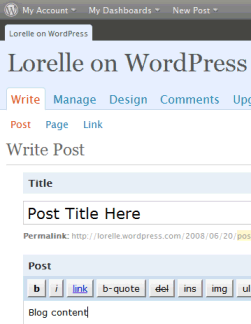 Last week’s blog challenge was Describe Your Computer Setup - Then and Now. This week, I am challenging you to blog about your blog software, then and now.
Last week’s blog challenge was Describe Your Computer Setup - Then and Now. This week, I am challenging you to blog about your blog software, then and now.
I’ve used just about all types of computer technology, from the early days of data storage on gigantic floppy disks to magnetic cards to “640K is enough for anyone” to my favorite current love, my 750 gig portable drive. Along the way, I had harsh words for most software, from the earliest Cobal and Fortran to Visual Basic to DOS to Windows, and a lot of other stuff in between.
From day one, I hated the lack of functionality, clear thinking, and usability in most software programs. “Clunky” was my favorite descriptive word. With little ability to style graphics in the early days, we were stuck with nothing but words on a green, amber, or white monochrome screen, putting more work into the manipulation of data than data presentation. Luckily, I was in the right place at the right time to help change much of that in the early days as an early beta tester and part of the program development teams with Microsoft, Apple, WordPerfect (Novell), and other early software companies, but it was a battle to get the concept goal desired to work with the limitations of programming and computer abilities at the time.
Slowly, software changed as hardware technology shrank, speed up, and became more flexible and versatile, and the ability to handle graphics improved. Programs became more colorful, faster, and usability became more important than just “pretty.” Competition, and trips to the courtrooms of intellectual property and product design, helped to actually create standardization, so we could install any program on any machine in a similar fashion, and all the buttons and menus were in basically the same place, speeding up the learning curve as you moved from program to program. WYSIWYG (What You See Is What You Get) became a slogan as programs now showed you what the final version would look like before you hit print or publish. Things seemed to become faster, but not always easier.
 My web life was totally changed when I switched my huge static HTML website to WordPress when WordPress had just released version 1.2. No longer was I burdened with long and frustrating search and replace sessions to change just one little bit of code across a thousand static HTML pages, then sitting through hours of FTP uploads to get the new versions on my site. My site loaded faster than ever with dynamic PHP/database driven template files and tags, and managing the content and the site itself went from being a week long job to a few minutes. No longer did it take hours to publish a single article.
My web life was totally changed when I switched my huge static HTML website to WordPress when WordPress had just released version 1.2. No longer was I burdened with long and frustrating search and replace sessions to change just one little bit of code across a thousand static HTML pages, then sitting through hours of FTP uploads to get the new versions on my site. My site loaded faster than ever with dynamic PHP/database driven template files and tags, and managing the content and the site itself went from being a week long job to a few minutes. No longer did it take hours to publish a single article.
 In order to customize any aspect or add a feature on my old site, I’d have to write up Javascript or hand code HTML and CSS. With WordPress, I could use WordPress Plugins - a couple clicks and a new feature is added to my site! One much more powerful than I could create.
In order to customize any aspect or add a feature on my old site, I’d have to write up Javascript or hand code HTML and CSS. With WordPress, I could use WordPress Plugins - a couple clicks and a new feature is added to my site! One much more powerful than I could create.
What did I use to make this static-to-import conversion? Software I used to depend upon that I haven’t touched in years. I used WordPerfect and InfoRapid freeware to search and replace across multiple text files. After Corel took over WordPerfect, it’s gone downhill for me. The last two upgrades of WordPerfect crashed randomly and without warning, and sometimes not even loading to start without errors. I do all my writing for my blog and other editorial work in NoteTab Pro and rarely do I need to search and replace across multiple files. On the rare occasions I have to write a letter or major document, I use Word, though I curse and scream every few minutes for the “improved” lack of usability and difficulties in completing the easiest of tasks. I’ve tried Open Office and it’s usability is also problematic, taking me three times as long to do what I could do in a few clicks or keystrokes in WordPerfect.
Where I used to use dozens of programs on my computer to do simple tasks, I find that I am using only a few programs and doing more focused work on them. A couple months ago I bought a new laptop and it took only a couple hours to get it up and running so I could work without stress and struggle. It would have taken days before to find the disks and upload all that software. I feel like a minimalist when it comes to my software dependency.
I could talk for ages about the powerful software I have used over the years that lost funding and support as the monopolies and slow thinking bureaucracy stifled software development within the corporate offices of the United States, which spread to the rest of the world quickly, leaving people using decent but uninspired programs - but this is your blogging challenge.
I want you to write about the software you use, whether it is software you used in your day-to-day work and life, or online software that brought the web into your life, as it was then and how it works for you today.
As usual, send a pingback or trackback to this post, or put the link to your blog challenge post in the comments, so we can all see how you’ve done with your blog challenge.
Did you know that you don’t have to write these blog challenges? You can also use audio with podcasts or make a video in response to the blog challenge and publish it on your blog. There are a lot of ways you can have fun with these weekly blog challenges. Use your imagination and see how far you can take the challenge into territories you haven’t explored before.
These blogging challenges are published weekly and are an attempt to kick your blogging ass. They serve to challenge your thinking and efforts in blogging and blog writing. To participate, start challenging yourself now. Today. Go for it.
Past Blogging Challenges
- Blog Challenge: Blog About Those Who Dare to Speak Out
- Blog Challenge: Who Would You Like To See Blog From History?
- Blog Challenge: What’s Your Blog’s Story?
- Blog Challenge: Blog Your Dash
- Blog Challenge: What is the Most Unusual Blogger You’ve Found?
- Blog Challenge: Write A Biographical Post
- Blog Challenge: Teach a Blogging Technique
- Blog Challenge: Write a Memoir of a Moment
- Blog Challenge: Shopping Experiences
- Blog Challenge: Write a Political Post

Site Search Tags: blog challenge, blogging challenge, writing, blog writing, computer software, software history, computer history, software development, how software influences your work and life
 Subscribe
Subscribe ![]() Via Feedburner
Via Feedburner  Subscribe by Email
Subscribe by Email  Visit
Visit
Copyright Lorelle VanFossen, the author of Blogging Tips, What Bloggers Won't Tell You About Blogging.

No comments:
Post a Comment